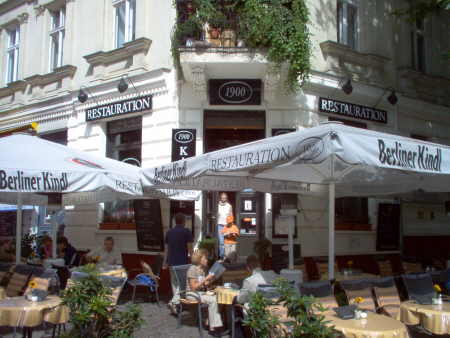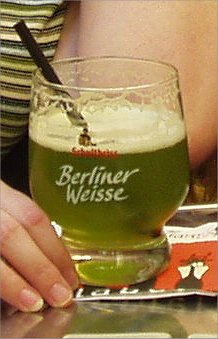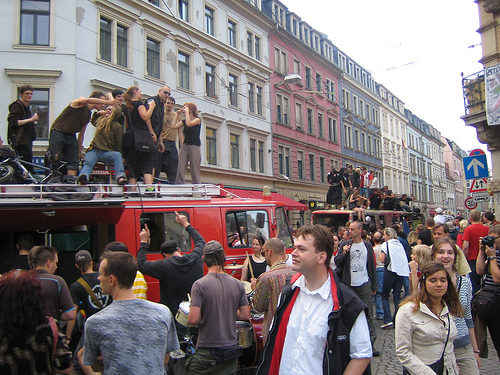It’s 6:11am here, and Leslie’s in the shower. The place is spotless, the better to recover the full security deposit. The last thing to get packed, of course, is the wireless router, but the time has come to snip our internet umbilical. Just 22 hours of travel stand between us and sweet, sweet home. What a summer it’s been. We’ll see you all soon.
Tag: travel
…and that was prague.
We just got back from what’s scheduled to be our list sub-trip, Prague. We gave our selves three days to see the city, which doesn’t seem like much, I guess. After the first day, which was dominated by a 4-hour walking tour of all the famous sights, we had trouble filling day two (maybe just because of our aching feet), and after a thwarted attempt to see the Simpsons movie (oops! only in Czech) and go to a “climbing bar” (oops! closed and replaced by trendy hotel), we gave up and retired to the Hostel. We took it easy on day three, but did revisit the castle more thoroughly than we had on the walking tour, and we glanced at (but did not enter, because we’re cheap) Kafka’s house on the castle grounds.
Next we endured 6 hours in a compartment of a train with every manner of family–first two people our age with a two year old son who was not happy about traveling on a train for 6 hours, and then a family of four with a 6-year-old daughter and 8-year-old son. These compartments are not big (in 2nd class) and you all face each other, knees interacting, trying to be polite, but really what I wanted to do was toss the squirming children out the window by the end of it (I didn’t; that sort of thing is also illegal in Germany).
So now it’s Tuesday, we’ve got just shy of three weeks left here, and with no more trips it’s time to dig in and figure out what else Berlin has to offer. Michael will come join us a week before we leave, which should be awesome, as he starts his second 10-week tour in Dresden.
We should have some Prague pics up soon.
still in germany
Yep, we’re still here. We went to Amesterdam last weekend, and posted the few pics we took there on the ol’ gallery. We just happened to be there the same weekend that Ali was meeting up with Karen to head on to their awesome-sounding trip to Italy, so we grabbed some dinner with them. Ali had his nice new camera with him, and got some great shots of what is really a beautiful and perfectly functioning little city.
We’ve been catching our breath back here a bit, and I’ve been working on the camera-ready version the mesh-improvement paper I wrote with Jonathan, which was finally accepted to the International Meshing Roundtable. So I guess I’ve got a trip to Seattle coming in October.
Next week we’re heading to Prague, and then we’ll have just a couple more left before we pack up. It’s amazing, the slowness and quickness of the way time passes over here.
barcelona pics up
Leslie busted out with posting and commenting many pics from our sub-journey to Barcelona. Check them out..
german beer curiosities
German beer is great. Everything you’ve heard is true. But there are some aspects of it that I wasn’t expecting that I think are worth sharing.
The sponsorship issue. When you go to any reasonable bar in the US, you can expect to find 4-10 beers on tap, usually representing a pretty good variety. Some American pilsner megabrew, probably some imported British macrobrew (Guinness, Harp, etc) a local macrobrew (usually Anchor Steam around SF), and if you’re lucky, 1-6 local microbrews. Going to fancier beer bars results in more numerous and esoteric options.

In Germany, practically every bar is ‘sponsored’ by one of a few major macrobrews: Erdinger, Berliner, Paulaner, etc. This means (as far as I can tell) the bar gets free umbrellas, signs, maybe some furniture, glasses, tap equipment at a reduced rate. Think of the old convenience stores around the US with giant coke-logo with tiny text underneath with the store name. The result of this sponsorship is that for some period of time–years, it seems–the bar is obligated to serve beers only from this brewery. So, at most bars, you can get one (usually quite good) variety of beer, probably a pilsener and maybe also a Hefewiessen, but that’s it. You specify the type of beer, and the brewery is determined by the sponsorship. You want another kind of beer? Switch your bar.
There are a few Irish pubs around that operate in the US-style, and so you can get several types of German beer there. Also, we’ve found two actual breweries, who tend to be independent and serve not only the house brews but several selections from local macrobrews.
The problem with good macrobrews. In the US, there are three huge macrobrews: Budwieser, Miller, and Coors. As far as I can tell, the beer from these three tastes more or less identical and is… not too popular among enthusiasts. This is probably because the beer is brewed mostly from rice syrup, not malt (i.e., grain), meaning it would not even be legal to sell it as beer in Germany (here, beer can contain only water, malt, hops, and yeast). Nonetheless, the vast majority of the beer Americans drink is from one of the big three. The result is that anyone looking for something else has to look at smaller breweries… from smaller but still national breweries like Sam Adams all the way down to boutique breweries like Stone that make comparatively minute quantities.
Here in Deutschland, though, the big brews are good. Like, really good. I still haven’t gotten tired of getting half a liter of Paulaner Hefe-Wiessbier or Franziskaner Hefe-Weisse Dunkel or a lighter Krombacher Pils, all for under 3 euros, less than you’d pay for a skimpy pint in the US. But the good macrobrews serve to block the proliferation of microbrews–why bother seeking out and trying a micro when all the beer around you is so decent? Hence, Germany has only a few microbrews, usually operating out of a single brew-pub. We have found a couple of them though, and the beer is quite good. But not really noticeably better than that you can get at any bar, hence the problem. So variety is lacking a bit, but the average quality is so high and the common beer is unfamiliar enough that I don’t really mind.
Strange concoctions. The last, and probably most unexpected, thing I’d like to mention is what they mix beer with and drink like it’s normal. Before we came, we were warned about the Berliner Wiesse weak beer mixed with fruit syrup. Although it’s indigenous, apparently only tourists drink it, which made sense to me, because why would you spoil good beer like that?

What blew me away is what people do drink. Exhibit A: Radler. This is beer mixed with some sweetened citrus, usually lemonade, drunk on hot afternoons or actually whenever if you’re a teenager. This stuff is so popular that you can even get it premixed, bottled in stores. Imagine my surprise when I spotted a classic German brew, Warsteiner, premixed in Lemon and Orange flavors! I’ve tried it… I can’t quite handle sweet+beer, but Leslie says she likes it. Exhibit B: Diesel. This is beer mixed with coke. I drank a whole one of these… it was pretty gross, but seems also to be quite popular (Warsteiner markets this mixture in bottles as well). Leslie has a theory that the younger crowd (drinking age here is 16, and unenforced) use these mixtures as training beers until they are ready for the real thing. Who knows.
Drinking in the streets. The last thing I want to mention is drinking in the streets, which is totally legal here. It takes a while to get used to seeing people just strolling along with a jumbo pilsener in one hand, but then you start to wonder what the big deal is, and why we can’t do this in the US. I have to admit being able to sip a beer while waiting for the laundry to dry at the laundromat made it a much more pleasant experience.
So that’s what’s funny about beer here. We’ve made plans for trips to Barcelona, Amsterdam, and Prague with the first starting next Tuesday, so I’m sure there will be more to share on the travel front soon.
christopher street parade pics
We’ve posted (but not captioned) a few more pics on gallery, including those from the Christopher Street Parade (the city’s big annual gay pride parade). Example:
finally, a few pics
Yesterday we did the whirlwind tour of Dresden with our tour guide, Michael. It’s really an awesome city–it’s easy to forget that “old” comes in much deeper shades here than in the US. We hit a few museums, reviewed the horror of the firebombing, looked at old things, etc. We did finally also upload our pictures since arrival, all available here. For example, here’s the view out of our flat’s window:
And here’s Michael and I enjoying our modestly sized beers in Dresden yesterday:
And here is an example of the fare available at the street festival:
first foray: dresden
We got into Dresden yesterday afternoon via the D-Bahn (a fast train system inside Germany and nearby countries). Cousin Michael met us at the platform and we took the tram and walked back to his place. The cool thing about Dresden at the moment is the Bunte Republik Neustadt festival, which as far as I can tell converts the entirety of the Neustadt (“new city”) section of dresden into one continuous party. Still no pics of our own, but here is someone elses to give you a bit of an idea:

You can see some more here. So we walked through some of the setup of the party, dumped our stuff at Michael’s flat, then hit the best biergarten we’ve been to so far by a long shot. It’s one of the three original breweries that have been here for hundreds of years, called Waldschloesschen. We ordered big beers (half a liter) but our waitress goaded Michael and I to upgrade to the 1 liter stein, which turned out to be a great way to kick off the night. The food was awesome… a giant roasted chunk of pig (I think a knuckle?), potatoes, and as always, cabbage. Then we walked through the now-blossoming party, put sick Leslie to bed, then had a couple of more beers out on the street as we looked to meet up with some of Michael’s friends. We did about midnight, and I called it a day and crashed back at his place.
Now I’m up, but no one else is, so I figured out how to get the wireless key for the network here and now I have sweet, sweet high-speed bliss. Maybe once Les wakes up I’ll try to get some few first pictures uploaded, assuming we brought the right cable with us.
berlin: we’re here
Today is our third day in Berlin. Things are still pretty insane, so I won’t yet write much. Not even any good pictures to post. The flights were fine; I was lucky and got some sleep on the transatlantic leg (leslie couldn’t get a wink). We arrived, got the key to our cute little flat (and I do mean little… but what would we do with more space, having only three suitcases to live out of?), and started to wander around Mitte (the central district in Berlin) looking for my institute. We eventually, through our first successful foray into German speaking, found it, and I met the very kind staff who installed me in my office and started me through the labyrinth of paperwork that is German bureaucracy. We managed to stay up until almost 8pm on our “new day.”
Yesterday we spent the morning finding a grocery store and allergy medicine (something here gets to both of us), then I went in to the lab, figured out how to buy a train ticket to Dresden for the weekend, then came back and we managed to get a bank account so we could pay for DSL in our flat (that will take two weeks to be installed, so don’t expect to hear to much for us until then), and even got a pair of “handies,” which is what they call cellphones here in a bit of using-english-words-that-english-speakers-don’t action (another example: a tuxedo here is called “ein smoking). We repaired to our home base where leslie cooked up a darn good seared chicken with onions and tomatoes (cooking at home here is basically unheard of, but the kitchen is well-appointed), then got through another 30 minutes of a movie before collapsing.
Today I’m trying to catch up on email and prepare for a talk I’m giving tomorrow afternoon at the institute. I’ll try to get some photos of some kind up soon.
deadline two, qual exam: check.
Another big sigh of relief: on Thursday I gave my qualifying exam talk–and passed. The qual at Berkeley is a bit different from most places; it’s basically a proposal of your thesis topic in the form of a two-hour talk given to a committee of four professors, who pepper you with questions throughout, ostensibly to test your knowledge of the area and to confirm that your thesis topic is “good enough.” I’ve spent most of the last two weeks making the slides and otherwise preparing for the talk. Although in theory you can fail your qual (and be kicked out of the Ph.D. program), I’ve never heard of it happening. This is because your advisor really shouldn’t let you take your qual until he knows you’re ready to pass. In reality, the hardest part of the qual is getting four professors to all agree to be in the same place for two hours on your behalf.
Anyway, it went fine, which means my thesis topic (TETS!) has the stamp of approval and I’m officially ABD (all but dissertation). I wish I could say that’s the last loose end for the semester, but I’m currently working on the take-home final for my graduate theory class and optimistically polishing up the SGP paper for it’s final “camera ready” version. We don’t yet know whether it will be accepted (and hence whether a camera ready version will even be necessary), but because the deadline for submitting the camera ready version is right in the middle of my honeymoon, I think I’d rather hedge and do the work now.
Oh yeah… we got an apartment in Germany. It’s smack in the middle of everything, about 15 minutes on foot from WIAS where I’ll be working, and 500 feet from a major transportation hub. Literally the ‘B’ in Berlin:
